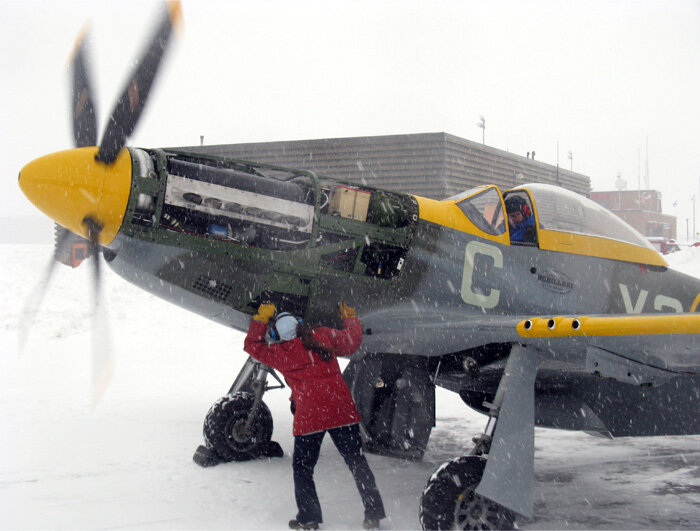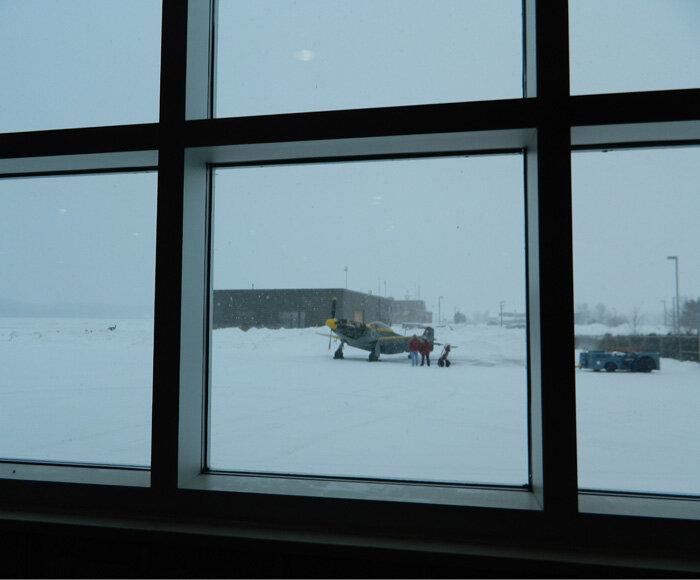MUSTANG ON ICE
The 442 Squadron Mustang delivers an icy and granular blast to the face of photographer Dave O'Malley
You call your self a warbird mechanic? Really? You short pants wearing, candy-assed, sun-block covered, flip-flop shod, sunny weather warbird mechanics from Kissimmee, Florida, Mojave, California, or sunny Jindalee, Queensland have nothing on the grease-covered, snowsuit-wearing, frozen-to-the-core, toque-capped and smiling Merlin Wizards at Vintage Wings of Canada. If you work with the hangar doors open in Florida, the breeze is lovely. If you do that in Canada... it's deadly. If you bash your knuckles in a Canadian winter, no need to get a bandage... the blood freezes in a few seconds and God help you if you lick a wing.
When a Canadian warbird gets a winter oil change, it still needs to be run up to circulate the oil and check for leaks. It doesn't matter if your Weather Channel radar shows a blue to purple mass of arctic cold and heavy precip the size of France hovering over your hangar or if the rooftop anemometer is about to spin right off its pole – she's gotta get run up.
This week, I happened to be at the hangar installing new roundel decals on the Harry Hannah Stearman when one of our mechanics courteously informed me that the hangar doors would soon be opened wide to drag out the Mustang for a run-up. All morning the radios were broadcasting winter storm warnings, predicting low temps, ice pellets mixed with snow and rain and high winds.... not the best conditions for good adhesion of my roundels. Time to down tools and wait.
In a Gatineau winter, the doors just have to be cracked open for three minutes and the entire maintenance staff suffers for a half hour as the heating system struggles to deal with the sudden 20ºC temperature drop, but open them wide enough to drag a P-51 Mustang outside, and the hangar becomes a meat locker for an hour. Despite interior temperatures low enough to see their breath, the mechanics on the floor worked as though nothing had changed.
Vintage Wings pilot Blake Reid and I donned our winter gear and a couple of point and shoot cameras to photograph the Mustang as she sat out on the snowy ramp. As soon as we stepped outside, we saw the Mustang in a completely different light from the thousands of times we had viewed her before. Here, with her wheels covered in compressed snow, with the wind howling and ice building up on her wings and with poor visibility in every direction, she looked not like the pampered, primped and polished multi-million dollar baby that she is, but rather, for the first time, like the working, fighting, gritty and frankly disposable, operational fighter that she once was. Here, for the first time I witnessed a warbird in bad weather, in poor conditions, in low light, in an uncomfortable situation. Here for the first time, I was seeing a warbird that looked like... well, a bird of war.
In the snow and clag that surrounded her, she looked more sturdy and dependable than ever before. She looked for the first time to be in her element. I thought then of Flying Officer Rocky Robillard walking out to her on a crappy day just like this somewhere in Holland, France or Germany in the terrible winter of 1944-45. I thought of the 442 Squadron mechanics working in the very same conditions all day and night out on a wind swept field in Europe long ago. And I watched the newest generation of Canuck Mustang mechanics doing the same work in the same conditions... 70 years later.
Here's to the finest breed of warbird mechanic on the planet today - the Vintech Aero Merlin Wizards
As the winter front drives snow, sleet and ice pellets mixed with rain across the Vintage Wings ramp, Vintech Aero AMEs Angela Gagnon and André Laviolette position the Mustang so that its wake will not blow snow and ice over cars in the parking lot. Photo: Blake Reid
Angela Gagnon is “dressed for success” as she backs the mule away from the Mustang. Note the patio/deck in the background where pilots and mechanics sit with their cold beers on a summer evening to watch the sun set and the last warbird doing circuits. Not a particularly inviting spot this day. Photo: Dave O'Malley
Related Stories
Click on image
“Calisse, she's cold, mon chum!” Having grown up in Buckingham, Quebec, not ten kilometers from the Vintage Wings ramp, AME André Laviolette is used to bone-numbing weather, blinding snow and ice pellets - but that was just walking to kindergarten, not starting a Mustang on the ramp. On the side of the fuselage we see the newly installed dedication panel for "Les Frères Robillard (The Robillard Bros.). The Robillard brothers grew up in this region and knew full well the awesome nastiness of an Ottawa Valley winter storm blowing down from Pembroke. Rocky Robillard, the younger of the two actually flew Mustang Y2-C (marked as ours is) for 442 Squadron on days like this. Photo: Dave O'Malley
Laviolette readies the Mustang for a winter start as the photographer positions himself behind – not a wise idea it turned out. Photo: Dave O'Malley
Unfortunately the point and shoot camera freezes the propeller instead showing the full disc, making this shot seems sort of peacefully quiet and not as extreme as it actually was. Photo: Blake Reid
Add 100 knots of prop wash to 20 knots of icy winter wind and you have a wind chill factor approaching absolute zero and skin abrasion approximating sand blasting. Gagnon shines a flashlight into the guts of the engine bay to check for oil leaks while Laviolette powers up. With the prop wash blowing back, it's good to have boots with a deep tread and a firm grip on the aircraft. Photo: Dave O'Malley
Just so you don't think the photographers Reid and O'Malley are as tough as our AME's – after five minutes in the wind, cold and snow, they retired to the relative comfort of the hangar and shot through the window as Gagnon and Guy Richard discuss the success of the run up. Photo: Dave O'Malley












